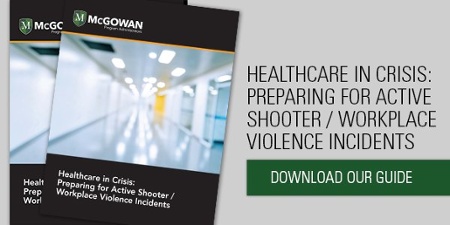Hospital shootings are on the rise over the last two decades. A 2012 Annals of Internal Medicine study identified 154 shootings between 2000 and 2011. There were a handful of incidents reported in 2000, but in 2015, more than 20 shootings occurred in hospital facilities. Unfortunately, active shooter events on hospital grounds are now nearly a monthly occurrence.
One recent incident at Chicago’s Mercy Hospital & Medical Center on November 19, 2018, left four people dead, including an emergency room physician, a first-year pharmacy resident, a police officer, and the gunman. And late last year, on October 3, 2019, a woman was shot by her stepfather in the Elmhurst Memorial Hospital parking lot in Elmhurst, Illinois. Unfortunately, lawsuits quickly follow these tragic events and become headline news.
Why do hospitals struggle to address active shooter threats?
Because hospitals are places where the sick, injured, elderly, and immobile people go for care and to heal, hospital staff face massive challenges keeping patients safe and evacuating them when necessary. From a logistical standpoint, the size and complexity of hospital environments make planning for an active shooter incident difficult. Hundreds of thousands of patients and visitors may enter and exit a healthcare facility every day. Many departments have several entrances and exit points. Effectively monitoring each department, recognizing potential threats, and responding to incidents in real-time requires a highly complex plan.
Beyond logistical challenges, the origins of hospital shootings are not predictive. Even with police or security guard presence in many departments, especially in emergency rooms, many active shooter events start within the hospital. Additionally, on several occasions, the firearm used in the incident was taken from an onsite officer or guard.
A study conducted by Johns Hopkins researchers found many hospital shootings take place outside the building or near the hospital entrance, negating the use of metal detectors to prevent these incidents. The Hopkins research team concluded that specialized training for law enforcement and security personnel, such as proper securing of firearms, is a more effective deterrent to active shooter incidents than investing in expensive or intrusive technology like metal detectors and magnetometers.
Responsibilities of healthcare employers
Now that active shooter events have become more common, healthcare executives, leaders, and staff must work toward limiting the damage, injuries, and deaths from these events. In 2016, OSHA updated its healthcare safety field Rule 3148, Guidelines for Preventing Workplace Violence for Healthcare and Social Service Workers, to include an active shooter incident plan for healthcare facilities.
The new OSHA active shooter standards include:
- Educating and creating awareness among healthcare workers about the possibility of an active shooter event.
- Incorporate preventive measures based on past shooting events.
Hospitals that are not compliant with OSHA recommendations can be held liable for any injuries or deaths that occur during an active shooter incident. Already, several lawsuits have been filed in court against hospitals for negligence or inadequacies in security procedures.
One example comes from the Mercy Hospital shooting referenced at the beginning of this article. The family of the pharmacist killed in the shooting filed a lawsuit arguing the hospital failed to take basic safety and security measures that could have saved the pharmacist’s life.
Hospital active shooter safety plans
Hospitals nationwide are responding by upgrading staff training, technology, and security measures to prepare for a potential shooting. Some upgrades include entrance security upgrades like more expansive ID checks. Many facilities are installing badge-access checkpoints and metal detectors for specific units. Annual emergency-preparedness reviews are also helping hospital staff practice informed safety measures.
 hbspt.cta.load(49319, ‘981624c9-c4a6-4442-aa58-43ba3a25a300’, {});
hbspt.cta.load(49319, ‘981624c9-c4a6-4442-aa58-43ba3a25a300’, {});
Your active shooter safety procedures should include a recovery plan
McGowan Active Shooter/Workplace Violence Programs address risks and establish a comprehensive policy to help healthcare organizations respond and recover from such incidents. McGowan’s Active Shooter/Workplace Violence Insurance covers liability and extra expenses tied to shootings, providing victim death benefits with additional medical expense benefits.
The program covers a wide range of attacks, such as knife and vehicular attacks, rather than solely attacks committed with a firearm. Get started today


